Kategorie: ‘Allgemein’
Excellent placement in global university ranking

© Kurt Beyer
In electrical engineering, RWTH Aachen is one of the three best German universities. This is the result of the internationally highly regarded QS Ranking by Subjects of the British information service provider Quacquarelli Symonds. Presented in its latest version, the subject ranking is based on various criteria that are weighted according to subject. An online reputation survey among university graduates and employers accounts for between 40 and 100 percent of the total points and is considered the most important indicator. Citations, which scientific papers from universities receive on average, account for up to 60 percent. For some engineering and natural science subjects, international research networks are also taken into account.
The Aachen University of Excellence was able to place itself on the winner’s podium in many subjects throughout Germany and is also convincing in an international comparison. In ten subjects, it placed among the 100 best worldwide. RWTH did particularly well in the subjects of mining engineering with 15th place and mechanical engineering with 19th place.
For more information: www.topuniversities.com
“Hex-Hex”: Text – Thesis written!

The right magic formulas are taught in the courses of the “Schreibwerkstatt E-Technik”. The face-to-face course offers bachelor’s and master’s students at the Faculty of Electrical Engineering and Information Technology customized preparation for writing their upcoming seminar papers or dissertations. Participants benefit from acquired basic knowledge and writing strategies, which can be further developed in an individual online consultation. Upon successful participation, students earn a certificate and 3 CP, which can be credited towards elective credits.
International students must prove a German language level of at least C1.2 as a participation requirement for the course. The online writing consultation takes place in either German or English.
Registration deadline: March 27 – April 3, 2023
Dates:
| Group 1 02.84000 |
Group 2 02.84000 |
| Wednesdays April 19, 2023 Mai 3, 2023 Mai 17, 2023 June 6, 2023 each from 2.30 to 5.30pm |
Wednesdays April 26, 2023 Mai 10, 2023 Mai 24, 2023 June 21, 2023 each from 2.30 to 5.30pm |
Registration is via user account at Language Center.
Contact for inquiries: schreibzentrum@sz.rwth-aachen.de
Top placements in international ranking
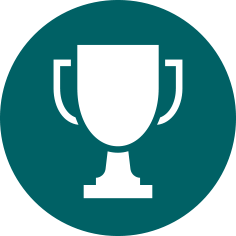
The portal Research.com informs in the newly published ranking that the Electrical Engineering and Information Technology of the RWTH achieved the 2nd place in the Germany-wide comparison. Internationally, RWTH ranks 65th in this discipline.
Research.com evaluates the frequency of citations of scientific articles and other publications for the ranking. Data from the OpenAlex and CrossRef databases are used for the evaluation. Researchers are ranked using the D-index, a variation of the H-index, which measures citations to their scientific papers within a discipline. All those who achieve a D-index of at least 30 are included in the rankings. The sum of the D-indexes of all listed scientists of a university is then decisive for its placement in the university ranking.
Accordingly, the following RWTH Electrical Engineering and Information Technology professors have qualified for the ranking:
- Dirk Uwe Sauer from the Chair of Electrochemical Energy Conversion and Storage Systems Engineering.
- Rik W. De Doncker from the Chair of Power Electronics and Electrical Drives
- Heinrich Meyr from the Chair for Distributed Signal Processing
- Antonello Monti from the Institute for Automation of Complex Power Systems
- Max Lemme from the Chair of Electronic Components AMICA – Advanced Microelectronic Center Aachen
- Steffen Leonhardt from the Chair of Medical Information Technology
- Petri Mahönen from the Chair and Institute of Networked Systems
- Rainer Leupers from the Chair of Software for Systems on Silicon
Into 6G era with innovative measurement technology

The team from the Chair of Distributed Signal Processing around Prof. Dr. Haris Gačanin will provide insights into the world of tomorrow at Mobile World Congress in Barcelona on February 27. Together with industry partner Rohde & Schwarz, they will present the interactive and immersive visualization of measurement technology using augmented reality. The “XR-Wireless” technology developed as part of the 6GEM research project is used for this. The partners are meeting the challenge of developing innovative test and measurement technology that masters the acceleration of new technology towards 6G.
Encouraging women to take up MINT professions – support for ZDF heute journal
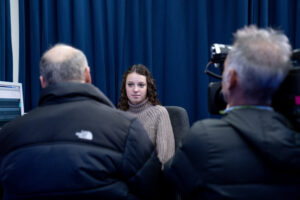
BA student Helena in an interview with the ZDF heute journal team. Photo: C. Antweiler
At the end of January, the team from ZDF heute journal visited the Institute for Communication Systems at RWTH Aachen University for a report. The report provides insights into the topic of “women in MINT subjects”, which are sometimes chosen even less by women and girls, such as mathematics, computer science, natural science and technology. Editor Peter Böhmer from the North Rhine-Westphalia State Studio researched the reasons for the low quota of women at RWTH Aachen University and what approaches could be taken to change this.
Through interviews with various female RWTH students, including our BA student Helena, as well as with Univ. Prof. Dr. rer. nat. Aloys Krieg, Prorector for Teaching, the heute journal team was able to gain an impression. The Institute for Communication Systems and a lecture by Prof. Peter Jax provided the pictorial framework for the report.
You can find the report in the ZDF Mediathek.
Gold and bronze at the 2023 Innovation Awards ceremony
Congratulations to all winners of this year’s Innovation Awards for pioneering university projects whose contribution particularly enriches the Aachen region as a location for innovation.
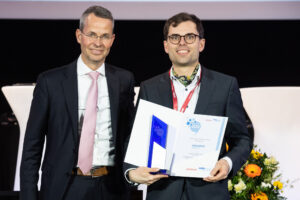
Professor Malte Brettel and award winner Dr.-Ing. Moritz Joseph from Team Neureka.
Gold went to the team Neureka around Professor Rainer Leupers from the Chair of Software for Systems on Silicon with a development kit on hardware – and software level for neuromorphic AI chips in edge applications.
Neuromorphic computing systems replicate the way the human brain works, as they combine computation and memory units and thus enable an enormous increase in performance in artificial intelligence. Neuromorphic chips already available today promise tens to hundreds of times improved energy efficiency, latency, and space efficiency. Neureka has successfully met the challenge of making the complicated system design of this technology accessible to industry.
The Hardware Development Kit integrates purchased neuromorphic chips into an existing computing system, allows validation of neuromorphic hardware, and is a development platform for market-ready AI devices. The software development kit enables easy programming and simulation of AI applications on neuromorphic systems. Software developers can thus bring low-risk AI applications to disruptive neuromorphic hardware and reduce the energy consumption of AI.
Customers of both developments are industrial users, mobile device manufacturers and smart city IoT device providers.
Silver went to an electromagnetically heatable nanomodified stent for the treatment of hollow organ tumors, developed in collaboration by Ioana Slabu of the Institute of Applied Medical Engineering and Benedict Bauer of the Institute of Textile Engineering.
Bronze went on the one hand to the team working with Mathias Bode from the Institute of Technical Combustion in cooperation with the Jülich Supercomputing Centre. Their software-as-a-service platform JuLES is considered a key technology for the climate-neutral transformation of industrial processes.
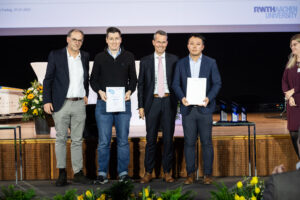
Professor Heinz Pitsch with Mathis Bode to the left and Weihan Li to the right after the handover of the certificate by Professor Malte Brettel.
On the other hand, the team from the Chair of Electrochemical Energy Conversion and Storage Systems Technology, headed by Professor Dirk Uwe Sauer, was also pleased to receive bronze. The award honored the development of a digital battery twin to increase efficiency and safety in the application field.
Lithium-ion batteries are emerging as the technology for energy storage, especially in the field of electromobility, due to their low cost and high energy density. However, their performance degrades over time. Condition monitoring and prediction of battery aging not only benefits safety, maintenance, and asset optimization, but is also the starting point for technical and economic analysis of potential second-life applications.
The developed cloud battery management system covers seven key functions to control the entire life cycle of batteries, enabling online monitoring of aging, prediction of aging progression, and optimization of operation strategy to limit aging.
The innovation contributes to the acceleration of the energy transition and the electrification of transport. It also opens up commercial opportunities for a wide range of industries, such as digital certificates for batteries, battery warranties and insurance, and predictive and timely warning of safety-critical conditions.
New research center CARL ushers in a new era
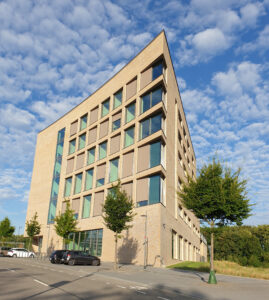
CARL research building as a 6-story new building with a sloping roof, standing in solid construction in research cluster F along Campus Boulevard.
We congratulate the Institute for Power Electronics and Electrical Drives on moving into the new research building CARL – Center for Ageing, Reliability and Lifetime Prediction of Electrochemical and Power Electronic Systems – on the Melaten campus.
Three large laboratory halls as the heart of CARL and an interdisciplinary research network of ten core professorships, about 20 other chairs and institutes of RWTH Aachen and Forschungszentrum Jülich will now make it possible to push groundbreaking research work on battery aging and lifetime prediction of power electronics from a holistic perspective. “We want to understand down to the atomic and crystal level how energy storage devices function and respond to different requirements,” says Professor Dirk Uwe Sauer of ISEA, explaining the fundamental idea behind CARL.
Test benches for load and environmental simulations are set up in the first laboratory area. For example, this involves electrical, mechanical, chemical or climatic influences on the materials and systems of batteries and power electronics. Here, aging processes are run and analyzed in fast motion, as it were, in order to be able to investigate their causes in detail.
The second laboratory area deals with the construction of prototypes. The performance of entire systems or even individual components is to be examined here in order, for example, to be able to rule out material or design faults at an early stage.
Finally, the third laboratory area is dedicated to physical-electrochemical analysis. With the aid of an analysis chain for structural and material investigations, which will include a state-of-the-art computer tomograph with unprecedented resolution, the structures of the material can be examined and analyzed down to atomic resolution.
Consideration will be given to both the end user and the developer of machines and materials for the production of batteries and power electronics. “With our research results, we can help accelerate development cycles and ultimately save money by optimally configuring systems,” says Professor Sauer. This is because the question of service life is essential for economic considerations. For example, it is important for car manufacturers to be able to estimate depreciation periods, warranty services and reliability as part of functional safety.
Christmas greetings and closing times over the holidays
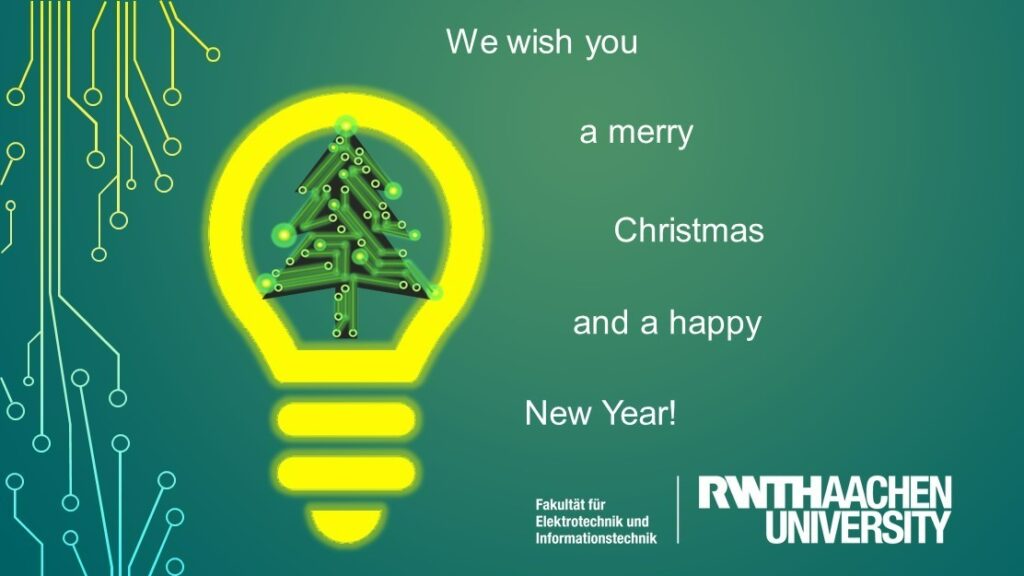
Otto Junker Awards 2022
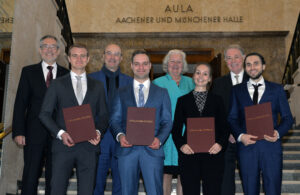
Image: Ryan Benkert, Daniel Fallnich, Josefin Wilkes and Tomasz Engelmann (front, from left) were awarded the Otto Junker Prize. Wolfgang Bleck, Ulrich Rüdiger, Marianne Conradt and Udo vom Berg congratulated the winners (back, from left).
Photo: Andreas Schmitter
Awarded for outstanding academic achievements
Ryan Benkert, Tomasz Engelmann, Daniel Fallnich and Josefin Wilkes received the 2022 Otto Junker Prize for their outstanding academic achievements. The Otto Junker Prize is conferred annually to RWTH students from the Faculty of Electrical Engineering and Information Technology and the Materials Science and Engineering Division of the Faculty of Georesources and Materials Engineering.
The Otto Junker Foundation was founded in 1970 by Dr.-Ing. E.h. Otto Junker. As a former RWTH, he felt intimately connected to the University throughout his life and particularly valued the scientific exchange. The aim of the foundation is to support young scientists and to promote numerous individual projects. Udo vom Berg, Chairman of the Supervisory Board of Otto Junker GmbH, and RWTH Rector Ulrich Rüdiger presented the awards at a ceremony. Professor Wolfgang Bleck, Chairman of the Foundation’s Scientific Advisory Board, and District Mayor Marianne Conradt congratulated the winners.
Ryan Benkert was born in January 1997 and did his Abitur in Gilching. He then studied electrical engineering, information technology and computer engineering at the RWTH and completed his master’s degree with a grade of 1.0. The master’s thesis with the topic “Out-of-Distribution Detection for Unsupervised Perception Systems” was written at the Chair for Integrated Systems of Signal Processing under the direction of Professor Gerd Ascheid. During his studies, he completed a stay at the Georgia Institute of Technology, funded by the Deutschlandstipendium and a Georgia Tech scholarship. He also completed three internships in the US, one of which was in Cupertino at Apple. Benkert is currently receiving his doctorate at the Georgia Institute of Technology in Atlanta, USA.
Daniel Fallnich, born in 1996, comes from Hanover and completed a voluntary science year in the field of production technology after leaving school. He then studied electrical engineering and information technology at the University of Hanover in the bachelor’s program. He switched to the RWTH for his master’s degree and studied electrical engineering, information technology and computer engineering. Here he was on Dean’s list of the best students. Fallnich also completed a six-month course at the TU Delft in the Department of Quantum and Computer Engineering. The master’s thesis with the topic “Design of a Hardware Architecture for the Niederreiter Cryptosystem” was written at the Chair for Integrated Digital Systems and Circuit Design under the direction of Professor Tobias Gemmeke. Fallnich is currently working at IBM in Böblingen.
Friedrich Wilhelm Awards 2022
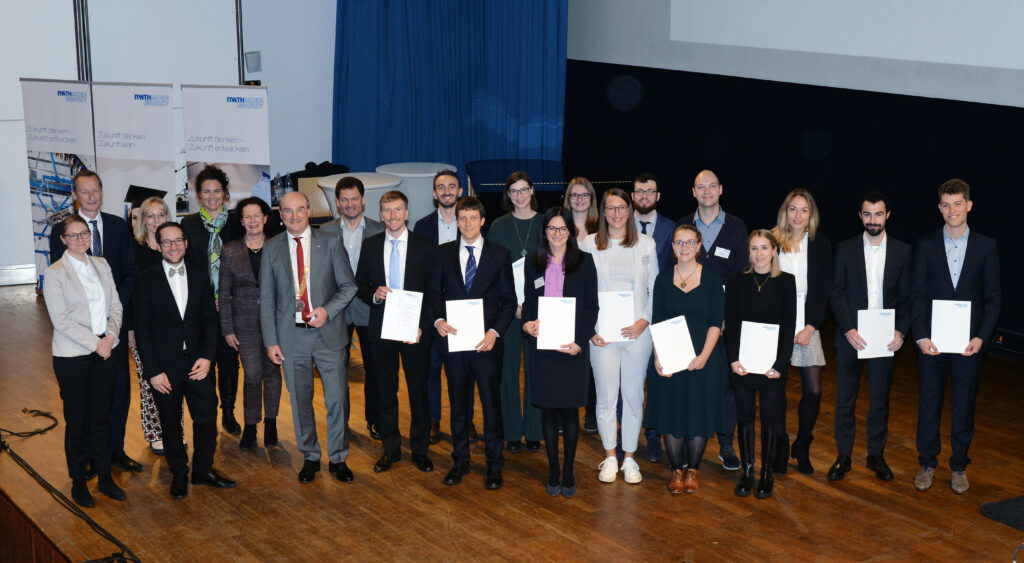
RWTH Rector Ulrich Rüdiger honored 17 outstanding graduates of RWTH Aachen University with the Friedrich Wilhelm Awards 2022.
Photo: Andreas Schmitter
Honoring outstanding achievements by RWTH Aachen graduates
The Friedrich Wilhelm Prize is awarded annually by the foundation of the same name in the form of prize money to students and researchers at RWTH Aachen University who have been selected for their outstanding achiements in their theses. Among this year‘s recipients are Maxim Christian Maria Müllender, Master of Science, from the Institute of High Voltage Equipment and Grids, Digitalization and Energy Economics and Laurids Schmitz, Master of Science, from the Institute for Power Electronics and Electrical Drives. Both winners were recognized due to their excellent master‘s theses.
Funding for research and teaching
The name of the foundation goes back to the Prussian crown prince and later Emperor Friedrich Wilhelm III., who founded a polytechnic institute in the Rhine province in 1858 using a donation from the Aachen and Munich fire insurance companies. In doing so, he laid the foundation for both the Rheinisch-Westfälische Technische Hochschule and the Friedrich Wilhelm Foundation, which is founded 1865 by the legal predecessor of today‘s Aachener und Münchener Beteiligungsgesellschaft. Since then, the promotion of research and teaching and the support of students and researchers at the RWTH Aachen have been the central concerns of the foundation.



